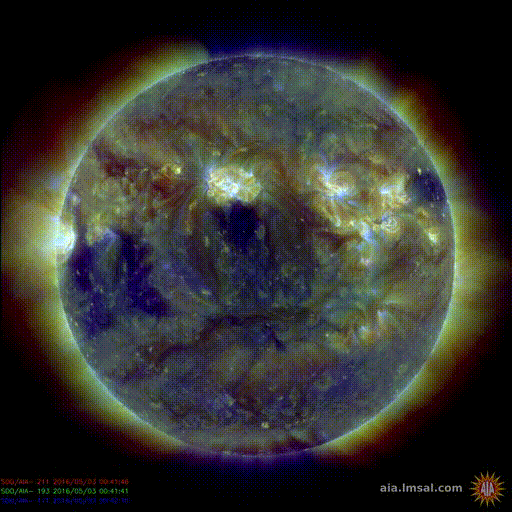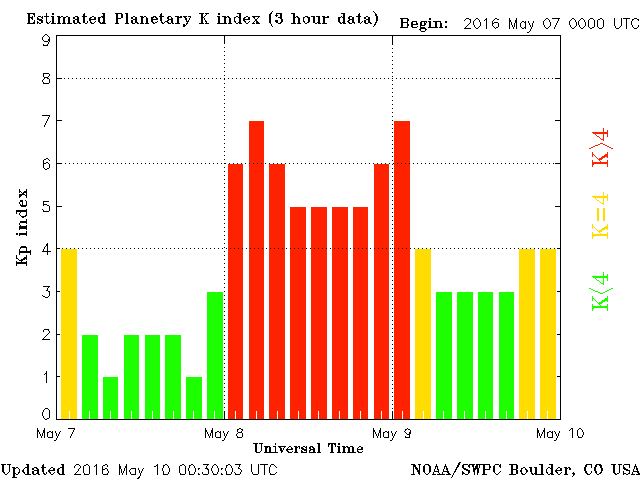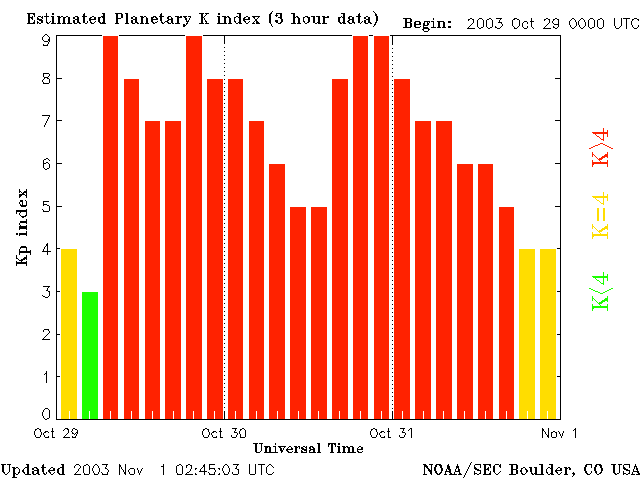Early May, one small and one large coronal hole transited the solar disk's centre. As expected, the associated high speed streams arrived at Earth just a few days later.
Solar wind speeds around 700 km/s were recorded, with the interplanetary magnetic field directed southward ("negative" values) at moderate but persistent levels. In the SDO/AIA imagery underneath (LMSAL at http://sdowww.lmsal.com/suntoday_v2/ ), the dark blue patches are the coronal holes, whereas the bright patches represent active regions.

The Kp index is one of several parameters that is used to evaluate the level of disturbance of the Earth's geomagnetic field. It is a 3-hourly index varying from "0" (quiet) to "9" (extremely severe). See the 2014 news item at http://www.stce.be/news/243/welcome.html for more info. As it happened on 8 and 9 May 2016, the estimated Kp was 5 or higher for 9 consecutive 3-hour periods (27 hours!), as can be seen in the NOAA graph underneath.

Regular space weather observers immediately noticed this was not something that occurs frequently. A closer look was taken at the Kp values available at the World Data Center for Geomagnetism in Kyoto (http://wdc.kugi.kyoto-u.ac.jp/kp/index.html ), which has data since 1932. Any period with a Kp of 5- or higher was considered as geomagnetic storming. Note the Kyoto values may differ slightly from NOAA's daily estimated Kp (http://www.swpc.noaa.gov/products/planetary-k-index ), but it's not changing much the general conclusions.
Since 1996, there have been 35 intervals with 9 or more consecutive 3-hour periods of geomagnetic storming. Only 5 (five!) of those have occurred during the ongoing solar cycle 24 (SC24). Put in another way: We had 30 long duration storm intervals in 13 years (1996-2008, SC23), then only 5 in the last 7 years (SC24 so far). The previous intervals for SC24 were 7-8 October 2015 (10), 22-23 June 2015 (9; Solstice storm: http://www.stce.be/news/313/welcome.html ), 17-18 March 2015 (9; St-Patrick's day storm: http://www.stce.be/news/301/welcome.html ), and 15-16 July 2012 (10).
Since 1996, the longest interval occurred during the Halloween storms (29-31 October 2003), when no less than 20 (twenty) consecutive 3-hour periods of geomagnetic storming were recorded. The corresponding NOAA diagram has been attached underneath for comparison with that from early May 2016.

Since 1932, there have been only 13 intervals with 20 or more consecutive 3-hour periods of geomagnetic storming. The longest such interval apparently occurred in 1951, with geomagnetic storming raging from 19 till 23 September (31 consecutive 3-hour periods, that’s 93 hours!...). Clearly, we are not used anymore to such lengthy storming periods!





